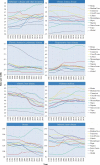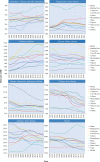Temporal trends in the burden of non-communicable diseases in countries with the highest malaria burden, 1990-2019: Evaluating the double burden of non-communicable and communicable diseases in epidemiological transition
- PMID: 36274138
- PMCID: PMC9589679
- DOI: 10.1186/s12992-022-00882-w
Temporal trends in the burden of non-communicable diseases in countries with the highest malaria burden, 1990-2019: Evaluating the double burden of non-communicable and communicable diseases in epidemiological transition
Abstract
Background: Non-communicable diseases (NCDs) are rapidly increasing in sub-Saharan African countries, where 96% of global malaria deaths occur. This study aimed to investigate the disease burden of NCDs in countries with the current highest malaria mortality.
Methods: Data for this study were obtained from the Global Burden of Disease 2019 study (1990-2019). We selected the ten countries with malaria's highest age-standardised mortality rate (ASMR) and identified and ranked the five NCDs with the highest ASMR in each country. Measures of the NCDs disease burden included ASMR, age-standardised disability-adjusted life-years (DALY), years of life lost (YLL) and years lost due to a disability (YLD). The Estimated annual percentage change (EAPC) was used to examine the trends of the NCDs disease burden from 1990 to 2019.
Results: As of 2019, the ASMR of chronic liver disease, kidney disease, diabetes mellitus, Alzheimer's disease and other dementias, hypertensive heart disease and stroke were higher than the global average. From 1990 to 2019, the ASMR for Alzheimer's disease and other dementias, type II diabetes mellitus, and chronic kidney disease increased by 3.0%, 10.8%, 13.3%, and the age-standardised DALY rate increased by 3.7%, 27.6%, 6.3%, and the increases tended to be in younger populations.
Conclusion: The double burden of non-communicable and communicable diseases is crippling the health systems of many sub-Saharan African countries and is often neglected. The prevention, surveillance, and control of diseases require an integrated strategy, with governments and non-government organisations aligned and supported by the global initiative.
Keywords: Double burden of disease; Malaria; Non-communicable disease.
© 2022. The Author(s).
Conflict of interest statement
The authors declare no competing interests.
Figures




References
-
- UNAIDS. (2022) Global HIV & AIDS statistics — Fact sheet. In: Joint United Nations Programme on HIV/AIDS. https://www.unaids.org/en/resources/fact-sheet. Accessed 28 Aug 2022.
-
- WHO. (2021) Global Tuberculosis Report 2021. In: World Health Organazation. https://www.who.int/teams/global-tuberculosis-programme/tb-reports/globa.... Accessed 12 Sep 2022.
-
- WHO. (2022) Malaria. In: World Health Organazation. https://www.who.int/news-room/fact-sheets/detail/malaria. Accessed 30 Jun 2022.
-
- WHO. World malaria report 2021. World Health Organization; 2021.
Publication types
MeSH terms
LinkOut - more resources
Full Text Sources
Medical
Research Materials

